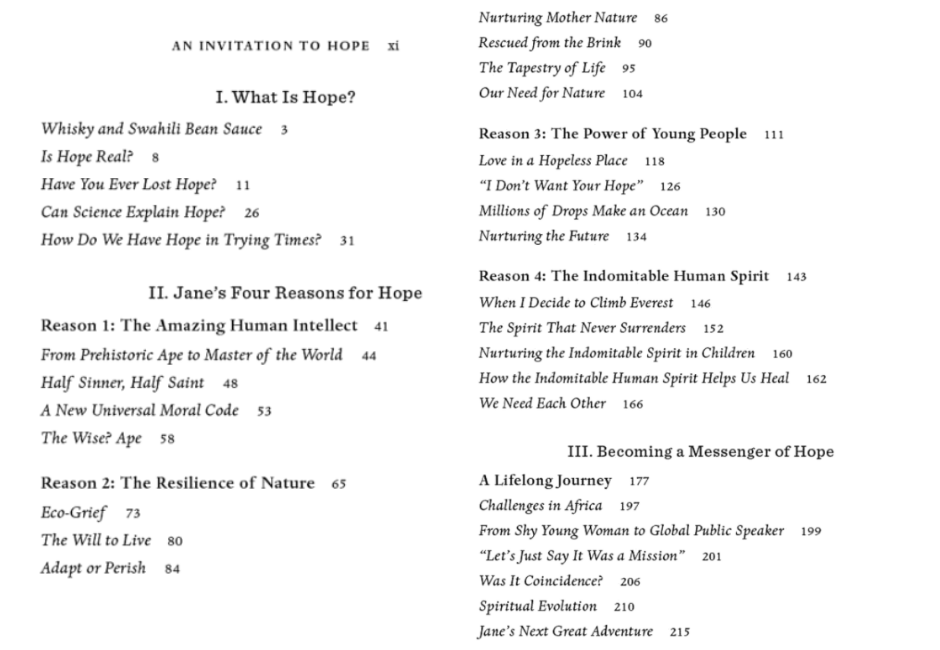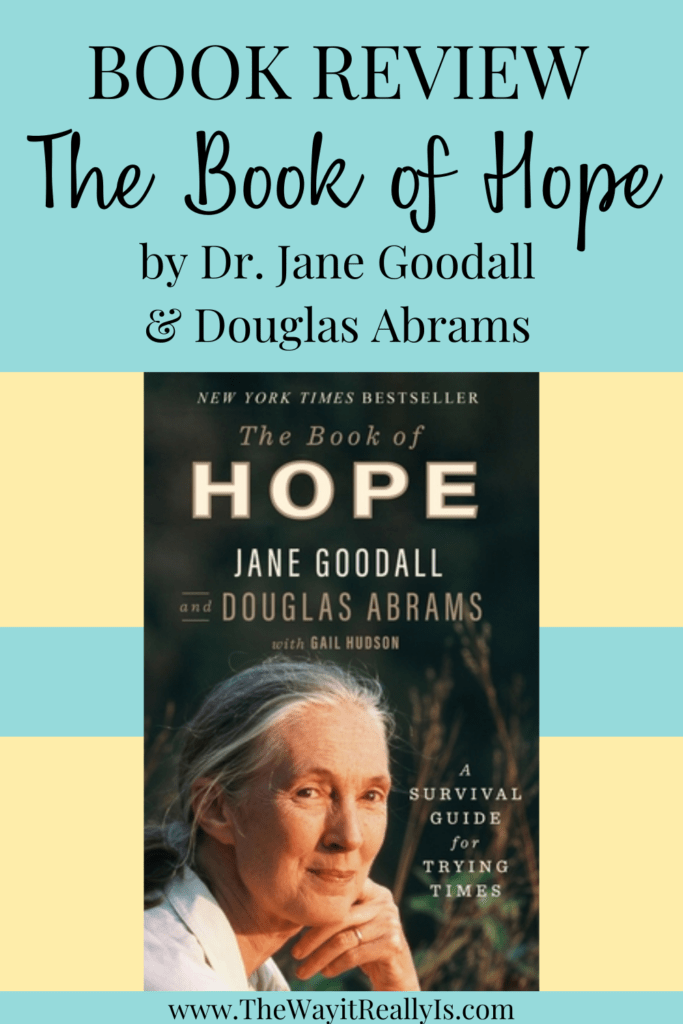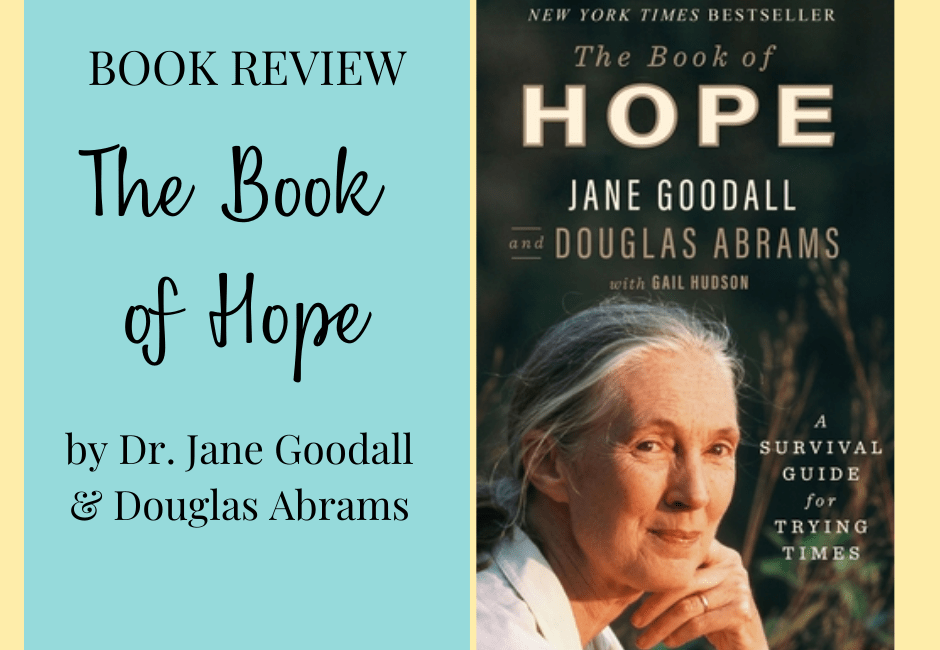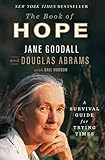Looking for an inspiring read? The Book of Hope: A Survival Guide for Trying Times by Dr. Jane Goodall and Douglas Carlton Abrams is an inspiring book about how to get through even in difficult times, even now.
Douglas, whom she refers to as Doug, serves as the narrator and they have a back and forth conversation throughout the book where Dr. Jane Goodall shares with us what she’s learned about in her travels all over the world, and how to find hope in any situation. It’s so wonderful to hear her voice as narrator of her story.
Note: As an Amazon Affiliate I earn from qualifying purchases made through affiliate links, at no extra cost to you. Read my full disclosure for more information.

Part 1: What is Hope?
Doug starts out narrating about how they met up at Dr. Goodalls’s home that doesn’t have a regular address or streetlights so he had a hard time finding the place.
Hope is what enables us to keep going in the face of aversity. What we desire to happen, but we must be prepared to work hard to make it so…Hope is a human survival trait and without it, we perish.
Dr. Jane Goodall, The Book of Hope
Doug and Dr. Goodall discuss her early life including her being a great student but not having the money for college. She joined forces with Dr. Lewis S. B. Leakey and went into the wilderness in Gombe with her ‘Mum’ looking for chimpanzees to study. She only had 6 months of money to support her research.
It is believed that Dr. Goodall’s breakthroughs are due in part to her not attaining a university degree so that she could better study the emotions and behaviors of the chimpanzees. She speaks of the first chimpanzee who trusted her, David Graybeard, after so much time trying to gain their trust, and she finally felt like she might get somewhere. After this, National Geographic took on funding her research when the initial grant ran out and send a person to record her. The man, Hugo, ended up becoming her romantic interest before long and first husband.
If she hadn’t had hope in the beginning that she could gain the trust of the chimps, she would have given up. Luckily, that wasn’t the case.
In 1986 she feels that everything changed because she brought together a conference and found that chimps were being killed and/or used for medical research, put in zoos, or circuses. She went on to learn a lot about the villages that surrounded the forests where the chimps lived and what was causing these behaviors to occur. She knew that in order to save the lives of the chimps, the lives of the people living near the chimps had to be improved upon in such a way that they no longer needed to sacrifice chimps in order for the human’s survival.
Dr. Jane Goodall and Doug go on to discuss the differences between hope and faith, hope and optimism, hope and nature vs. nurture, and more.
Part 2: Jane’s Four Reasons for Hope
Dr. Jane Goodall shares that we have learned that chimpanzees, crows, pigs, and rats are very smart and able to learn a lot. Octopuses have a brain in each of their 8 arms and bees are able to be trained. There is still a lot to learn about animal intelligence. Human brains have developed beyond animal brains due to language, Dr. Goodall notes.
Dr. Goodall notes that in these trying times, we need a new universal moral code of “Do unto others as they do unto you” and that would solve it all. Though she admits it seems impossible that this would ever happen. She does feel we’re headed in the right direction and that the majority of people are good and kind. Dr. Goodall feels we don’t know about these good things because the media is too focused on the bad in the world. Many things such as standing up for human rights, standing up against injustice, standing up for animal rights, and more show steps forward toward a better global ethic.
Doug shared thoughts with Dr. Goodall regarding the steps back that we seem to have taken recently in terms. She admits that though it may feel that we are going backward, we are seeing so many do good in the world and stand up for others as well.
Dr. Goodall discusses the four great challenges we must solve. The challenges are alleviating poverty, we must reduce the unsustainable lifestyles of the affluent, we must eliminate corruption, and we must face up to the problems due to the growing population and livestock.
The four reasons for hope are 1. The Amazing Human Intellect, 2. The Resilience of Nature, 3. The Power of Young People, and 4. The Indomitable Human Spirit. Each of her 4 reasons for hope are further explored in this part of the book.
Dr. Goodall and Doug discuss different kinds of resistance such as built-in resilience, and how adaptability is essential to survival. They also discuss that we all have a choice to make a difference in the world and we can start in our local community. They discuss some programs that she has been part of that help instill hope, help others, and help the environment. One of the programs she discusses is Roots and Shoots.
Dr. Goodall speaks of how she’s so proud of so many children who are stepping up in their communities and within their own homes to raise awareness even with their parents regarding environmental issues and helping form their own groups to help others.
At the end of this section, Doug and Dr. Goodall part ways just months before the COVID-19 pandemic begins. Doug mentions they had no idea how much more important hope would become.
Part 3: Becoming a Messenger of Hope
This section begins during the COVID-19 pandemic in 2020, something truly unexpected. They had wanted to meet in person but had to meet via Zoom almost a year after the previous section had been written. By the time they met, so many had gotten sick and died from the pandemic.
Though they met through Zoom, she showed him around her home and all of the photos and stuffed animals she surrounds herself with. Each having a story. It’s so neat to hear her tell stories throughout this book.
As many likely already know, one of the earliest things Dr. Goodall did was get people to start testing on chimps in labs and stop killing them for their meat. It’s amazing how she did this and to hear what all it took to accomplish her mission.
Would you believe that Dr. Goodall was shy as a child? She was! She used to be afraid of talking in public or to people she didn’t know. She was able to overcome her fear and help so many chimps, people, and other animals.
Conclusion
The conversation between Dr. Goodall and Doug ends and then a beautiful, thoughtful conclusion by Dr. Goodall ends The Book of Hope. She speaks of how so many things have changed for her, and everyone else, due to COVID-19. She notes that she is able to reach many more people virtually though she dearly misses being in person and the immediate feedback and energy she used to get from speaking in person. She speaks of what we need to do to continue to live on and her next adventure, as well as acknowledgements.
Doug also has a closing including acknowledgments.
Summary
I truly enjoyed listening to The Book of Hope as read by Dr. Jane Goodall and Douglas Abrams. I especially liked listening to it now as I feel so many of us are low on hope as the pandemic drags into it’s third year. It’s timely to listen to this as well since it was just published last year and speaks of the pandemic.
I’ve known of Dr. Jane Goodall for most of my life as I was introduced to her in elementary school, but admittedly hadn’t read anything that she wrote in the past, so it was even more wonderful to hear her speak her own words about her past, present, and future.
I didn’t go into much specific detail in this book review as I don’t want to give it all away. I hope I’ve included enough to intrigue you though, this is a great read, and if you can, a great listen. The audiobook is about 7 hours long and I listened to it over the span of two days.

As a mom of identical twins and a son two years older, I have gained invaluable experience in the realm, and chaos, of parenting. With a Master's Degree and Education Specialist Degree in School Psychology, I spent years as a school psychologist, helping children navigate through their educational and emotional challenges. Now as a stay at home mom and professional blogger, I combine my areas of expertise to help you in your parenting journey.



Love this artcile!